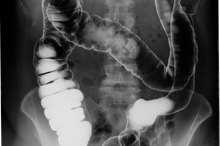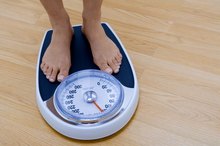Abdominal Pain Caused by Laxatives
Laxatives are over-the-counter medications used to help relieve and prevent constipation. These products work by creating soft or loose stools or by inducing a bowel movement. While these products may be recommended by your doctor and often work to alleviate the constipation, they can have side effects -- particularly if they are not properly used. Adverse effects of laxatives include diarrhea, nausea and abdominal discomfort or pain from bloating, gas and cramping.
Bulk-Forming Laxatives
One way to prevent constipation is to soften and increase the size of the intestinal contents, so digested food moves more quickly through the colon. With action similar to dietary fiber, bulk-forming laxatives or fiber supplements absorb water, increasing stool bulk. Within the gut, fast movement of poorly digested food components can lead to abdominal discomfort, so high or frequent doses of bulk-forming laxatives can lead to gas, bloating, diarrhea or other abdominal discomfort. As with most laxatives, bulk-forming laxatives work best and may pose fewer side effects when adequate fluids are consumed.
- One way to prevent constipation is to soften and increase the size of the intestinal contents, so digested food moves more quickly through the colon.
- Within the gut, fast movement of poorly digested food components can lead to abdominal discomfort, so high or frequent doses of bulk-forming laxatives can lead to gas, bloating, diarrhea or other abdominal discomfort.
Osmotic Laxatives
Movicol Side Effects
Learn More
Osmotic laxatives are commonly used for treating constipation, and when used as directed, they can be effective. These laxatives work by drawing fluid into the intestines, essentially causing this extra fluid to add to stool contents and help flush out the bowel. Examples of osmotic laxatives include products containing magnesium, phosphate or poorly absorbed sugars such as lactulose. While using these to treat constipation or push out the hard stool, these laxatives may cause abdominal discomfort such as gas and bloating -- and excessive or improper use can cause dehydration.
- Osmotic laxatives are commonly used for treating constipation, and when used as directed, they can be effective.
Stimulant Laxatives
Stimulant laxatives cause the intestinal muscles to move or contract, and this helps the intestines move the stool into the rectum for evacuation. Bisacodyl and senna are common laxatives in this cateogory, and they usually work within several hours. These laxatives can also lead to symptoms such as cramping, diarrhea and bloating -- often within a few hours of use. Overuse or high doses of these laxatives may even lead to dehydration and electrolyte abnormalities in the body.
- Stimulant laxatives cause the intestinal muscles to move or contract, and this helps the intestines move the stool into the rectum for evacuation.
Safe Use
Ex-lax & Weight Loss
Learn More
While occasional laxative use can work well to treat constipation, sometimes increasing fluid, dietary fiber and exercise can avoid the need for laxatives. If you are pregnant, have any preexisting gastrointestinal conditions or plan to use laxatives in a child, first talk with a doctor. Also, laxatives can interfere with medication absorption, so if you take any prescription medications, talk to your doctor prior to using laxatives.
Warnings and Precautions
If you have abdominal pain related to laxative use, or constipation that is not relieved by several days of laxative use, discuss your symptoms with your doctor 3. Overuse or abuse of laxatives can lead to abdominal discomfort and pain due to bloating, diarrhea, cramping, nausea. Also, sometimes laxatives do not work and the underlying reason for constipation needs to be assessed and treated. Laxative use can be dangerous if your pain is really caused by a more serious condition such as a bowel obstruction or appendicitis. Contact your doctor if you have a change in bowel habits, blood in your stool, severe abdominal pain or discomfort.
Reviewed by: Kay Peck, MPH, RD
- If you have abdominal pain related to laxative use, or constipation that is not relieved by several days of laxative use, discuss your symptoms with your doctor 3.
- Laxative use can be dangerous if your pain is really caused by a more serious condition such as a bowel obstruction or appendicitis.
Related Articles
References
- American Family Physician: Constipation
- Clinics in Colon and Rectal Surgery: Medical Treatment of Constipation
- BMC Gastroenterology: The Impact of Laxative Use Upon Symptoms in Patients With Proven Slow Transit Constipation
- American Journal of Gastroenterology: Myths and Misconceptions About Chronic Constipation.
- Jin J. Over-the-counter Laxatives. JAMA. 2014;312(11):1167. doi:10.1001/jama.2014.2078
- Portalatin M, Winstead N. Medical management of constipation. Clin Colon Rectal Surg. 2012;25(1):12–19. doi:10.1055/s-0032-1301754
- Use Certain Laxatives With Caution. U.S. Food and Drug Administration (FDA). January 1, 2014.
- Acosta A, Tangalos EG, Harari D. Constipation. In: Halter JB, Ouslander JG, Studenski S, High KP, Asthana S, Supiano MA, Ritchie C. eds. Hazzard's Geriatric Medicine and Gerontology, 7e New York, NY: McGraw-Hil.
- McQuaid KR. Drugs Used in the Treatment of Gastrointestinal Diseases. In: Katzung BG, Trevor AJ. eds. Basic & Clinical Pharmacology, 13e. New York, NY: McGraw-Hill; 2015.
Writer Bio
Gail Morris has been writing extensively since 1997. She completed a master's degree in nursing at Indiana University-Purdue University Indianapolis and practiced in medicine for more than 20 years. Morris has published medical articles in peer-reviewed journals and now writes for various online publications and freelances for Internet marketers.









